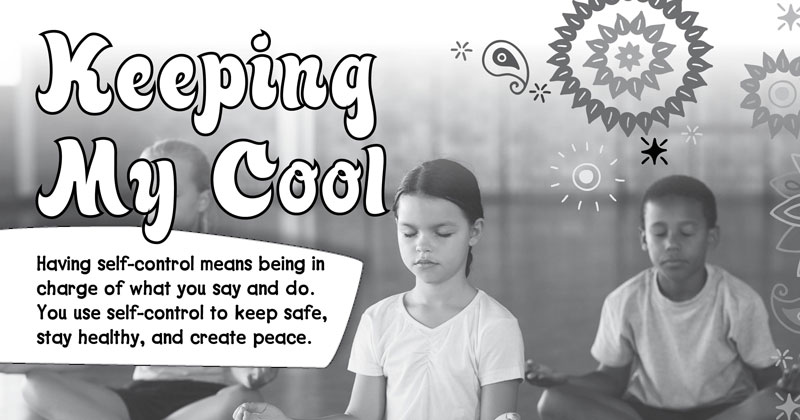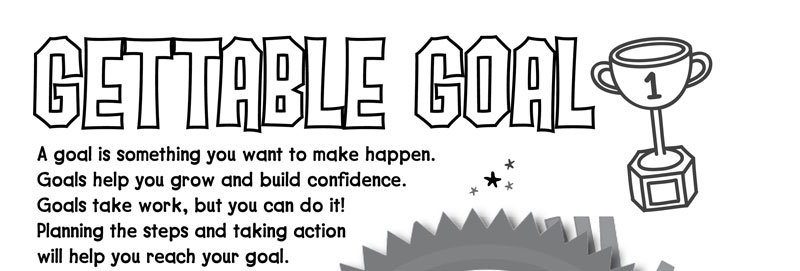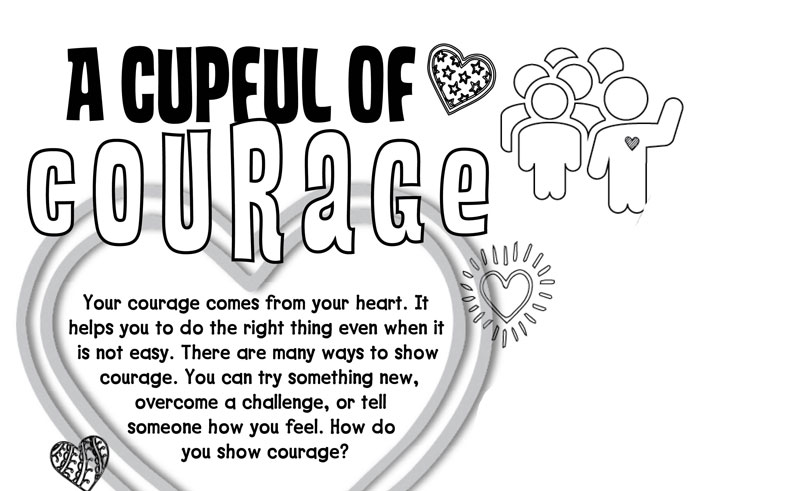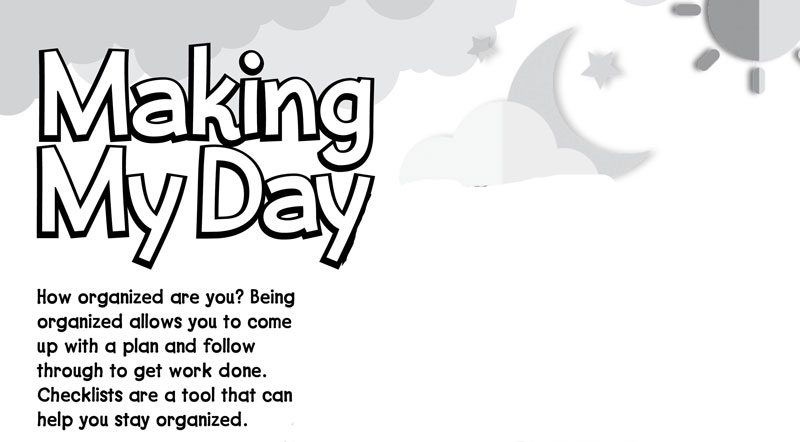Self-Management

Find this activity in the student portfolio
Objective: Students will be able to manage their emotions and show what it means to have self-control.
Estimated Duration: 20 minutes
Description: Self-control allows you to manage your thoughts, actions, and emotions so that you can get things done.
Having self-control can help students in all areas of life (e.g., waiting in line, taking turns, thinking before speaking) including socializing, performing well academically, and sticking with school tasks. But more importantly, it is a life-long skill that can help to reduce stress and increase wellbeing.
This activity will help students learn how to keep their cool when they are feeling out of control. They will write and draw about ways to be safe, stay healthy, and create peace.
Teachable Moments: There are many ways you can help students have self-control:
- Help students avoid temptation and clear distractions, so they can be successful.
- Reward self-control.
- Have frequent reminders of rules, especially before difficult tasks (e.g., raise your hand and wait to be called on before you answer the question).
- Play games that practice self-control.

Find this activity in the student portfolio
Objective: Students will name and work toward achieving a personal goal.
Estimated Duration: 20-25 minutes
Description: Setting goals helps students become more confident in themselves, helps them make better decisions in their life, and gives them motivation to keep going.
Setting and achieving goals can be enormously powerful for students. By measuring and celebrating their achievements, students can see what they have done over a period of time. They can see what they can do if they put their minds to it. Seeing their results gives them reassurance that they can achieve even higher goals in the future.
Discuss with students the importance of setting goals that are realistic. Setting small, achievable goals that can be done quickly will help them understand the process of setting and achieving goals. Once they grasp this concept, they can set even bigger goals. Make sure the goals they are setting are measurable, achievable, and specific.
Once they grasp this concept, they can set even bigger goals. Make sure the goals are measurable, achievable, as well as specific.
This activity has students name and make a plan for achieving a goal. The activity steps them through the process of making the plan and makes sure the goal is achievable.
Teachable Moments: There are many ways you can help students set and achieve goals:
- Help students name clear and measurable goals.
- Help students create a specific action plan for each goal.
- Have students read their goals often and visualize themselves accomplishing them.
- Have students reflect on their progress to see if they are on target.
- Help students revise their action plans if needed.

Find this activity in the student portfolio
Objective: Students will be able to identify how they show courage when facing challenges.
Estimated Duration: 20 minutes
Description: Courage is confidently acting in accordance with your beliefs, despite fear, difficulty, or opposition. It means using your heart to help you do the right thing even when it is not easy.
Showing courage can be as big as standing up to a bully, but it can also be as small as raising your hand to ask a question. Sometimes courage is quiet, meaning there is not always applause at the end.
Teaching the importance of being courageous can help increase student engagement, academic achievement, and self-esteem. It is important to encourage, recognize, and celebrate when students show courage because they might not even realize they are doing it.
This activity will allow students to express how they show courage. They can write or draw ways they show themselves and others what it means to be courageous.
Teachable Moments: There are many ways you can encourage students to be courageous:
- Tell students it is ok to be fearful. Courage often looks different than it feels. Sometimes on the outside it looks heroic, but on the inside, it can make you doubt yourself or feel scared.
- Give permission for imperfection; remind students that mistakes are how they learn.
- Ask students to try new things that might seem difficult. They could try a new food, choose a new seat at lunch or in class, learn a new strategy, speak in front of the class, or stand up for a friend.
- Celebrate risk-takers. Encourage students to take risks, even in the face of failure. Share stories of famous risk-takers and highlight the mistakes and failures they made.
- Be the example; communicate how you feel about trying to be brave or when you make a mistake and try again anyway.
- Share inspirational stories of courageous people from a variety of backgrounds (e.g., Harriet Tubman, Malala Yousafzai, Martin Luther King, Jr., Susan B. Anthony, Anne Frank).

Find this activity in the student portfolio
Objective: Students will be able to use planning and organizational skills.
Estimated Duration: 20 minutes
Description: Staying organized and knowing how to plan are particularly important skills for students since they help them learn how to prioritize activities, set and achieve goals, and reduce stress.
Teaching students the importance of organizational and planning skills can have a big impact on a student's ability to succeed throughout their academic career.
Organizational and planning skills are essential to a student's ability to interpret and retain information. It also makes it easier to collaborate with others and helps increase productivity and efficiency.
Students who have weak planning and organizational skills struggle with handling information in an effective and logical way. They often have difficulty setting priorities, making plans, sticking to a task, and getting things done. All these skills become increasingly important as a student moves through different grade levels.
This activity will help students learn how to create a checklist and to plan and organize their day. Students will create a checklist for either their morning or evening routine. They will pick the routine that they struggle with the most and make a checklist for it. They will need to write the task, describe the task, and tell the time of day it should take place.
Teachable Moments: There are many ways you can help students learn planning and organizational skills:
- Have students use checklists. Get them in the habit of using “to-do” lists.
- Help students sort and organize their homework assignments.
- Have students set a designated study time and place.
- Have students keep an organized notebook.
- Schedule a cleaning time for students.
Foldable®: Action Moments
Estimated Duration: 25-30 minutes

- Cut along the outside solid black lines of the large Self-Management Foldable. DO NOT cut the middle black cut-lines at this time.
- Fold along the dotted line on the right of the rectangle to form an anchor tab. Students might help each other fold. Glue the folded tab on top of the gray Self-Management anchor tab space in the student book. Allow the glue to dry briefly while discussing the three titles on the page.
- NOW cut along the middle two solid black lines to form three tabs. On the front of the tabs, have students color the words and draw pictures that show when they experienced moments of self-control, courage, and goal setting.
- Under the tabs, students answer “yes” or “no” by coloring the symbol that best completes their response to each sentence. Responses are personal and covered by tabs. Additionally, students can write words, phrases, or sentences on the blank space on the back of the three tabs.

- Cut out the Pocket Strip and the Thumbs Up-Down Card by cutting along the solid black lines.
- Glue the bottom edge of the Pocket Strip on the labeled gray strip in the student booklet. (Note that unlike anchor tabs, Pocket Strips have NO folds.)
- Allow glue to dry a minute before placing the Thumbs Up-Down Card in the pocket.
- Discuss the meaning of the Thumbs Up-Down symbol. Where have students seen it used? Show students how to rotate the card to give a thumbs up or a thumbs down. Students use the card to evaluate their Self-Management action moments.
- As a class, read the instructions to the right of the card in the student book. Read each prompt at the bottom of the page and give students time to respond. For those who want to, allow students to share their thoughts and responses. Tell students to visit this page when needed to self-evaluate their self-management skills by responding to the four statements at the bottom of the page. What changes do they notice? Discuss that it is ok to respond “No.” The purpose of this activity is to help them become aware of the times when they can manage themselves and the times when they struggle.
Go to other SEL competencies in this book (Primary - Grades 1–2):

The teaching suggestions only work in accompaniment with the student portfolio, which has all the activity pages.
The teaching suggestions here are also available within a PDF of the entire teacher's manual.